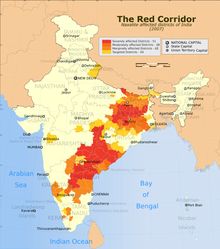India's Maoist insurgents, also known as Naxalites, are partially funding their long-running rebellion with profits from illicit opium poppy and cannabis crops, according to a new report from the Institute for Conflict Management. The groups also fund themselves through taxation of major corporations, farmers, and small businesses in areas they control.

The Naxalites are estimated to have between 10,000 and 20,000 men under arms, tens of thousands more organized into local militias, and sympathizers numbering in the millions. Indian Prime Minister Manmohan Singh has called them the single greatest internal threat to Indian security.
On Tuesday, in their toughest blow against Indian security forces since the rebellion began, Naxalites ambushed and killed 75 paramilitary police in Chhattisgarh state. Of a paramilitary expedition of 82 persons, only seven survived, and they were all wounded.
While India is one of a handful of countries licensed to produce opium for the legal medical market, it is also the home of substantial illicit poppy cultivation and, according to the report, the Naxalites are profiting from unlicensed opium fields in Jharkhand and Bihar states. Indian authorities report they destroyed opium crops worth $270 million on the black market in 2007. What is unknown is how much was harvested, with the profits ending up in Naxalite war chests.
The Maoists are also making money off cannabis. According to the 2008 Mohanty Commission of Inquiry, the CPI-Maoist and its front groups were behind extensive cannabis cultivation in Orissa state. One group, People's War, which later merged with the CPI-Maoist, was allegedly in charge of between 7,500 and 10,000 acres sown with cannabis.
Indian government officials have been urged to undertake opium eradication campaigns to undercut the Naxalites. They believe the Naxalites are not only benefitting from the illicit trade, but that cultivation of thousands of acres is taking place under their supervision.
In addition to buying guns, including heavy weapons, with the profits, the Naxalites are also spending on vehicles, including motorbikes with special tires to navigate the forests, supplies, communications equipment, and salaries for unemployed rural youth who join the armed struggle, the report said.
This work by StoptheDrugWar.org is licensed under Creative Commons Attribution-ShareAlike 4.0 International
Comments
The Poppy plant
All this because of a flower.
Add new comment